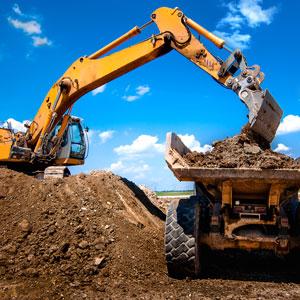Earth Moving
Earthmoving in Environmental Investigations
Earthmoving in Environmental Investigations
Earthmoving in Environmental Investigations is a common practice. Environmental scientists are required to assess and log soil and fill to depth on a given site and one of the best ways of achieving this is through excavation. Environmental works can also include clean up activities, referred to as remediation, which can include the stockpiling and aeration of soil requiring front end loaders and excavators. Finally once all environmental investigations are complete then the excavated soil often needs to be backfilled requiring plant such as rollers and compactors. Read our guide below to learn more about Earthmoving in Environmental Investigations.
Preliminary and Detailed Site Investigations
Often referred to as Phase 1 and Phase 2 investigations, preliminary and detailed site investigations are the foundation of all environmental investigations. A preliminary site investigation (PSI) typically includes a detailed review of a sites history including review of historic information such as aerial photographs and records, a detailed site walkover and on occasion collection of samples through intrusive works and excavations. The purpose of a PSI is to identify known or potential areas of contamination for further study. Examples can include leaking fuel tanks, heavy metal impacts and solvents.
A detailed site investigation (DSI) follows on from a PSI. Areas of interest and potential contamination issues identified during the PSI are targeted for sample collection. Depending on the contamination issues identified in the PSI sample types can include soil samples, groundwater or surface water samples and vapour samples. One of the most common methods of collecting soil samples is using an excavator to dig to depth. This activity is called Test Pitting and is completed by a team comprising an experienced excavator operator and an environmental scientist.
Test Pitting
Test pitting is a common activity in environmental investigations for the collection of soil samples for logging and laboratory analysis. Most test pitting will be completed to a depth of between 2 to 6m below ground level with the type and size of excavator selected based on required depth. Mini excavators ranging from size from a 1 tonne to 10 tonne excavator are typically used to reach depths less than 2m and in easier ground conditions such as topsoil and loose sub-surface soils. Benefits with using mini excavators include being able to reach hard to access areas that larger excavators cannot get too. Examples may include alleyways and spaces between buildings or sites with a lot of above surface infrastructure.
Larger 360 degree excavators between 20 and 30 tonnes are used for deeper investigations and remediation activities (see below for more information on remediation). With depth ground conditions can get difficult due to stiff and hard soil being compacted. Shallow weathered bedrock may also be present on many sites which requires a more powerful 20 or 30 tonne excavator to dig through.

Prior to breaking ground a dial before you dig (DBYD) search should be completed and the excavation area scanned by a qualified service locator to identify any subsurface services such as electricity lines, fiber optics and gas mains. The environmental scientist will generally lead the works instructing the excavator operator of the required sample collection depths. These typically include a surface topsoil sample, 0.5m depth and every 1m thereafter. It is common practice to segregate soils where possible based on appearance and contamination impacts. Examples include separating the topsoil for latter reinstatement and segregating notably impacted soils for later off-site disposal. The environmental scientist will be required to log the soil as it is excavated and will collect soil samples at regular depths. It is important that both the environmental scientist and excavator operator are clear in the requirements and work together to achieve them safely.
RemediationÂ
Earthmoving in environmental investigations is not limited to test pitting. Remediation includes the clean up of impacted soils and groundwater and earthmoving is an essential requirement of successful remediation activities. Remediation activities can include the excavation and off-site disposal of soils or landfarming.
The off-site disposal of impacted soil is often the last resort when it comes to environmental investigations and remediation due to the large costs involved with disposing soil to landfill. If off-site disposal is required for the project then it is important that soils are segregated into different waste streams to help minimize costs. In Victoria there are four streams of waste including Fill and Category A to Category C. Category A soil is the most heavily impacted and often cannot be diposed off-site before treatment to bring it down to at least Category B classification. Category B classified soil is the most expensive to dispose off followed by Category C and then Fill. If fill material is accompanied by a set of certified laboratory results confirming that there are no impacts then it can be re-used onsite of moved to another site for use.
Remediation activities during environmental investigations can also include stockpiling of soil and landfarming. Landfarming is typically applied to soils impacted with hydrocarbons and includes the addition of fertilizers and regular aeration of stockpiles. The intent of landfarming is to promote the growth of microbes naturally present within soil that will consume the hydrocarbons. The fertilizer provides essential nutrients to the microbes while regular aeration allows oxygen to penetrate the stockpile. Landfarming is a long term strategy that may take months or years to achieve its goal and often requires large areas to operate in. Landfarming will include the initial excavation of impacted soil using an excavator and then management of stockpiles using a front end loader or similar.

On heavily impacted sites the entire site may need to be excavated and treated one part at a time. This may be a time consuming process given the length of time needed for landfarming to take effect. Under current Australian guidelines the depth of excavations is typically 4m below ground level although it is not uncommon for greater depths to be reached. Depths greater than 4m will require benching and access ramps to provide stability and allow excavator access. These large scale remediation projects require sufficient planning to ensure they run smoothly.
Backfilling
Once environmental investigations and remediation activities are complete then excavated soils need to be backfilled. This is achieved by using excavators, rollers and compactors. Typically soil is placed back into the open excavations in layers of approximately 300mm before being rolled. This process is repeated several times until ground level is reach. Full compaction of soil to its original state will not be achieved and a backfilled excavation will need time to settle. A return visit to a site is required to ensure compaction has been completed successfully and either top of or level any slumps or raised ground.
Earthmoving in Environmental Investigations
Earthmoving in Environmental Investigations is an essential activity and can include excavation and movement of soils and the backfilling of excavations. Types of plant required can include mini excavators, larger 20 to 30 tonne excavators, front end loaders and rollers. Environmental Investigations are a requirement for a majority of development projects meaning that as an operator you can expect to be involved with one during your career. At Start Training we offer a range of Earthmoving Training courses that will prepare you for all types of site works.


